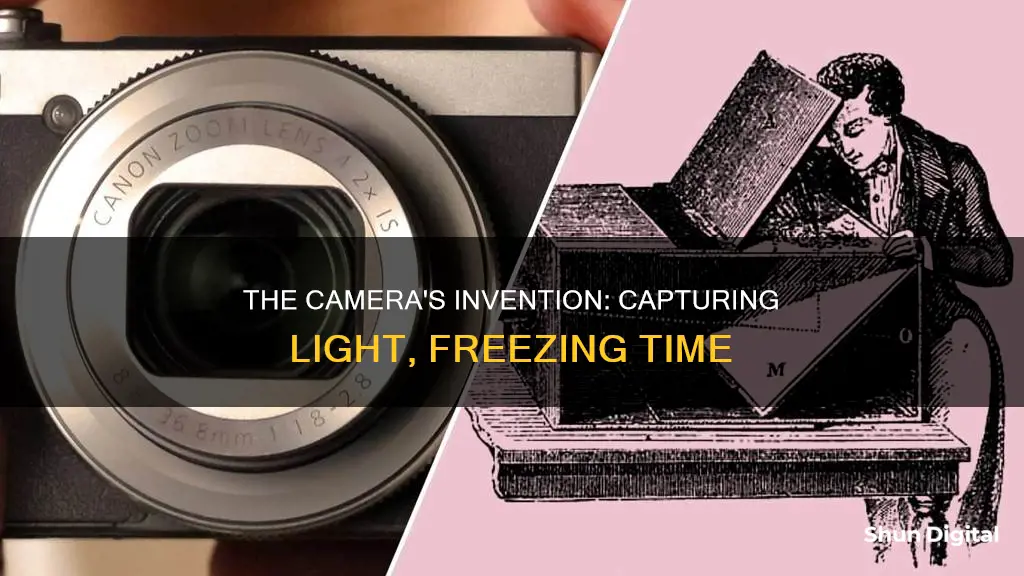
The history of the camera began long before the invention of photography, with ancient Greek and Chinese scholars experimenting with optics and light. The camera obscura, or dark room, is considered the first camera and was used as early as the 5th century BCE. Over time, cameras evolved from large, immobile devices that required long exposure times to capture images on plates or film to modern digital cameras that can fit in our pockets and capture images in an instant. The development of the camera is a story of human ingenuity, with pioneers like Joseph Nicéphore Niépce, Louis Daguerre, and George Eastman making significant contributions that have led to the cameras we know and use today.
What You'll Learn

The camera obscura
Ibn al-Haytham (Alhazen), an Arab physicist, made significant contributions to the understanding of the camera obscura in the 11th century. He provided the first correct analysis of the phenomenon, offering geometrical and quantitative descriptions, and was the first to use a screen for image projection. He also understood the relationship between the focal point and the pinhole, pioneering early afterimage experiments.
In the 16th century, Italian polymath Gerolamo Cardano suggested using a glass disc or biconvex lens in a camera obscura to view events outside, recommending the use of a white sheet of paper to avoid dull colours. The popularity of the camera obscura as a drawing aid grew, with portable versions in tents and boxes becoming common by the late 17th century.
The term "camera obscura" was first used in 1604 by German mathematician, astronomer, and astrologer Johannes Kepler, who also developed the first portable version in the form of a tent. The camera obscura played a crucial role in the development of the modern photographic camera, with Joseph Nicéphore Niépce adapting it to generate a permanent photographic plate in 1826 or 1827.
Exploring the Toggle Feature in Camera Raw
You may want to see also

The first photograph
The world's oldest surviving photograph was taken by Joseph Nicéphore Niépce in 1826 or 1827. The image, entitled 'View from the Window at Le Gras', is a grey-hued pewter plate with blurred shadow-shapes of treelines and buildings.
Niépce captured the photograph using a technique he invented called heliography, which produces one-of-a-kind images on metal plates treated with light-sensitive chemicals. To create the photograph, Niépce treated a heated pewter plate with bitumen of Judea, or Syrian asphalt, a naturally occurring asphalt with light-sensitive properties. He then placed the plate into a camera obscura, facing out of his second-story window. The camera obscura was kept open for at least eight hours, and possibly as long as two days. The bitumen hardened where the light was strongest, creating an image of the streetscape that only became visible once the unhardened parts of the asphalt were removed.
Niépce's pioneering work in photography continued, and in 1829 he entered into a formal partnership with Louis-Jacques-Mandé Daguerre. Together, they refined the heliographic process and, after Niépce's death in 1833, Daguerre introduced the "Daguerreotype" process in 1839.
Outdoor Game Motion Cameras: How Long Do Batteries Really Last?
You may want to see also

The daguerreotype
The process involved polishing a sheet of silver-plated copper to a mirror finish, treating it with fumes to make its surface light-sensitive, exposing it in a camera for as long as was deemed necessary, and then developing the resulting latent image by fuming it with mercury vapour. The image was then fixed with a liquid chemical treatment, rinsed, dried, and sealed behind glass in a protective enclosure.
Where is My Image Processor? Camera Raw's Missing Feature
You may want to see also

The calotype
In 1840, Talbot developed a different process, in which only a faint or invisible latent image was produced in the camera, which could be done in a minute or two if the subject was in bright sunlight. The paper was then removed from the camera and the latent image was chemically developed into a fully visible image. This process was introduced to the public as the calotype or talbotype in 1841.
Activating Standby Mode: A Simple Guide for Your Camera
You may want to see also

The gelatin dry plate
While the gelatin dry plate process was superseded by celluloid film in the early 20th century, it laid the foundation for modern photography and played a pivotal role in making photography more accessible to both professionals and amateurs alike.
Galaxy S7 Camera Mode: How to Access and Use It
You may want to see also







